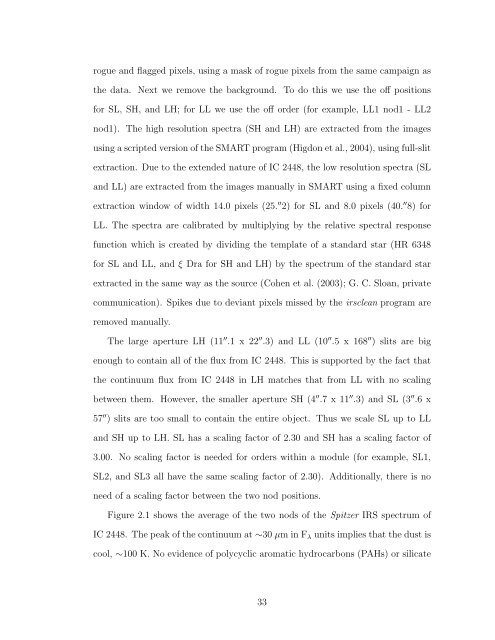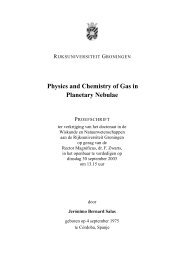TRACING ABUNDANCES IN GALAXIES WITH THE SPITZER ...
TRACING ABUNDANCES IN GALAXIES WITH THE SPITZER ...
TRACING ABUNDANCES IN GALAXIES WITH THE SPITZER ...
You also want an ePaper? Increase the reach of your titles
YUMPU automatically turns print PDFs into web optimized ePapers that Google loves.
ogue and flagged pixels, using a mask of rogue pixels from the same campaign as<br />
the data. Next we remove the background. To do this we use the off positions<br />
for SL, SH, and LH; for LL we use the off order (for example, LL1 nod1 - LL2<br />
nod1). The high resolution spectra (SH and LH) are extracted from the images<br />
using a scripted version of the SMART program (Higdon et al., 2004), using full-slit<br />
extraction. Due to the extended nature of IC 2448, the low resolution spectra (SL<br />
and LL) are extracted from the images manually in SMART using a fixed column<br />
extraction window of width 14.0 pixels (25. ′′ 2) for SL and 8.0 pixels (40. ′′ 8) for<br />
LL. The spectra are calibrated by multiplying by the relative spectral response<br />
function which is created by dividing the template of a standard star (HR 6348<br />
for SL and LL, and ξ Dra for SH and LH) by the spectrum of the standard star<br />
extracted in the same way as the source (Cohen et al. (2003); G. C. Sloan, private<br />
communication). Spikes due to deviant pixels missed by the irsclean program are<br />
removed manually.<br />
The large aperture LH (11 ′′ .1 x 22 ′′ .3) and LL (10 ′′ .5 x 168 ′′ ) slits are big<br />
enough to contain all of the flux from IC 2448. This is supported by the fact that<br />
the continuum flux from IC 2448 in LH matches that from LL with no scaling<br />
between them. However, the smaller aperture SH (4 ′′ .7 x 11 ′′ .3) and SL (3 ′′ .6 x<br />
57 ′′ ) slits are too small to contain the entire object. Thus we scale SL up to LL<br />
and SH up to LH. SL has a scaling factor of 2.30 and SH has a scaling factor of<br />
3.00. No scaling factor is needed for orders within a module (for example, SL1,<br />
SL2, and SL3 all have the same scaling factor of 2.30). Additionally, there is no<br />
need of a scaling factor between the two nod positions.<br />
Figure 2.1 shows the average of the two nods of the Spitzer IRS spectrum of<br />
IC 2448. The peak of the continuum at ∼30 µm in Fλ units implies that the dust is<br />
cool, ∼100 K. No evidence of polycyclic aromatic hydrocarbons (PAHs) or silicate<br />
33













